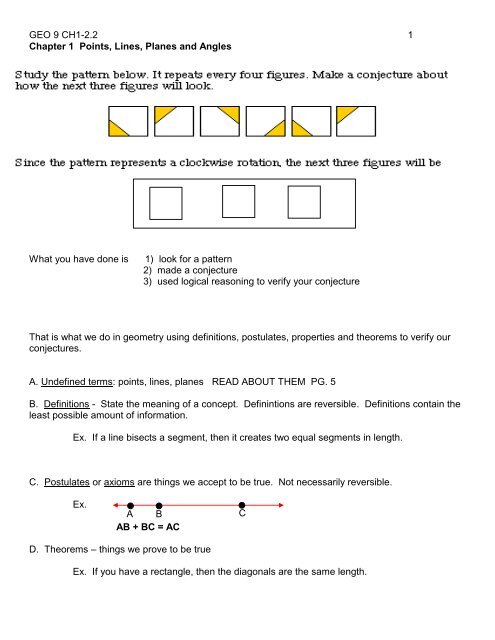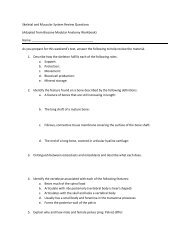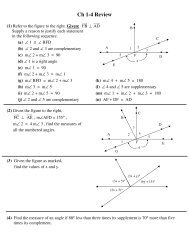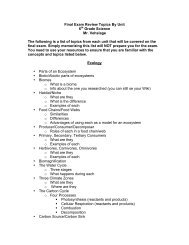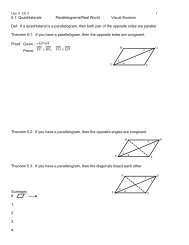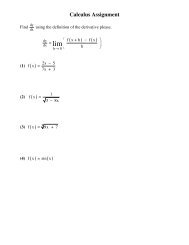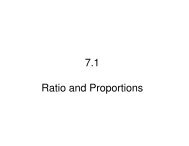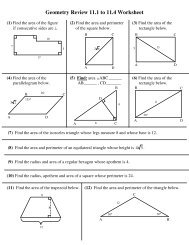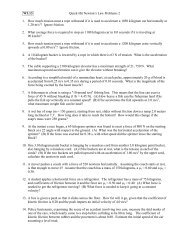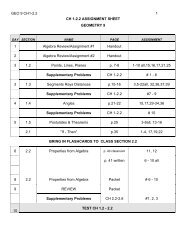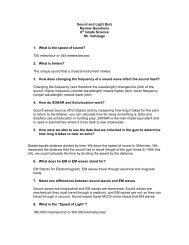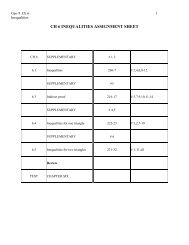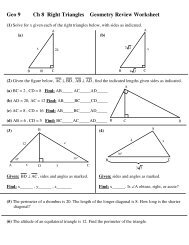Chapter 1 Points, Lines, Planes and Angles
Chapter 1 Points, Lines, Planes and Angles
Chapter 1 Points, Lines, Planes and Angles
Create successful ePaper yourself
Turn your PDF publications into a flip-book with our unique Google optimized e-Paper software.
GEO 9 CH1-2.2 1<br />
<strong>Chapter</strong> 1 <strong>Points</strong>, <strong>Lines</strong>, <strong>Planes</strong> <strong>and</strong> <strong>Angles</strong><br />
What you have done is<br />
1) look for a pattern<br />
2) made a conjecture<br />
3) used logical reasoning to verify your conjecture<br />
That is what we do in geometry using definitions, postulates, properties <strong>and</strong> theorems to verify our<br />
conjectures.<br />
A. Undefined terms: points, lines, planes READ ABOUT THEM PG. 5<br />
B. Definitions - State the meaning of a concept. Definintions are reversible. Definitions contain the<br />
least possible amount of information.<br />
Ex. If a line bisects a segment, then it creates two equal segments in length.<br />
C. Postulates or axioms are things we accept to be true. Not necessarily reversible.<br />
Ex.<br />
A B<br />
AB + BC = AC<br />
C<br />
D. Theorems – things we prove to be true<br />
Ex. If you have a rectangle, then the diagonals are the same length.
Geo 9 Ch 1-2.2 2<br />
Lesson 1.2 - <strong>Points</strong>, <strong>Lines</strong> <strong>and</strong> <strong>Planes</strong><br />
<strong>Points</strong>, lines <strong>and</strong> planes are intuitive ideas that are accepted without definition. These<br />
terms are then used in the definitions of other terms.<br />
Point -<br />
A<br />
Line -<br />
B C D<br />
Plane -<br />
H<br />
G<br />
E<br />
F<br />
E<br />
Horizontal plane<br />
F<br />
Vertical plane<br />
A<br />
D<br />
B<br />
C<br />
Parallel <strong>Lines</strong> –<br />
Perpendicular <strong>Lines</strong> –<br />
Skew <strong>Lines</strong> –<br />
Collinear –<br />
Non- Collinear-<br />
Sketchpad
Geo 9 Ch 1-2.2 3<br />
1.3 Segments, Rays <strong>and</strong> Distance<br />
SKETCHPAD<br />
Diagram<br />
Point –<br />
Segment –<br />
Ray –<br />
Opposite rays –<br />
Distance –<br />
Congruent –<br />
Equal –<br />
Midpoint –<br />
P<br />
Get into groups <strong>and</strong> find the following :<br />
Ex 1) The ray opposite to EG is _______<br />
G<br />
-2<br />
E<br />
-1<br />
O<br />
0<br />
M<br />
1<br />
T<br />
R<br />
2 3<br />
Y<br />
4<br />
2) The length of MG is ________.<br />
3) The distance between R <strong>and</strong> E is _______<br />
4) The midpoint of GY is _____________<br />
5) The coordinate of midpoint of GY is ___________<br />
6) Give me a rule for finding the coordinate of a midpoint<br />
_______________________________________________________________________<br />
_______________________________________________________________________<br />
7) Give me a rule for finding the distance between 2 points<br />
_______________________________________________________________________<br />
_______________________________________________________________________
Geo 9 Ch 1-2.2 4<br />
No little bar<br />
8) You are told that segment AB, notation AB, is 10 cm, segment AC is 3 cm,<br />
how long is segment BC You might have to think about this a little. A picture would<br />
definitely help.
Geo 9 Ch 1-2.2 5<br />
A. Segment Addition Postulate _____ _____ _____<br />
If B is between A <strong>and</strong> C, then<br />
Draw a picture:<br />
AB +BC = AC<br />
Ex.. If AB = 6 <strong>and</strong>BC = 8, then AC =<br />
Ex.<br />
If AC = 12, AB = 15, BC = 3, which point is between the other two<br />
Ex. If L is between P <strong>and</strong> Q, <strong>and</strong> PL = 6x-5, LQ = 2x + 3, <strong>and</strong> PQ = 30 What is x
1.4 <strong>Angles</strong><br />
Geo 9 Ch 1-2.2 6<br />
Angle Addition Postulate _____ _____ _____ ( Used two ways)<br />
A. If point B lies in the interior of
Geo 9 Ch 1-2.2 7<br />
T<br />
RECTANGLE TSRP<br />
S<br />
POWERPOINT p9<br />
O<br />
P<br />
R<br />
3a) If TPO=60 , how large is RPO a) ___________<br />
b) If PTO=70 , how large is STO b) ___________<br />
c) If TOP=50 , how large is POR c) ___________<br />
2. If CBD DBE <strong>and</strong> BD bisects CBE, find m A ( CAB) 2) ___________<br />
C<br />
D<br />
x+10<br />
A<br />
x+5<br />
60<br />
B<br />
E<br />
3. 1 2; m 1=x+14; m 2= x 2 - 4x 3) ___________<br />
Solve for x.<br />
2<br />
1<br />
4. m ABD=3x; m DBC=x; find m ABD. 4) ___________<br />
D<br />
A B C
Geo 9 Ch 1-2.2 8<br />
5. m FGJ=3x-5; m JGH=x+27; GJ bisects FGH. Find m FGJ. 5) ___________<br />
F<br />
J<br />
G<br />
H<br />
6. m ABC=90 ; m 1=2x+10; m 2=x+20; m 3=3x 6) ___________<br />
C<br />
1<br />
2<br />
3<br />
B<br />
A<br />
Has<br />
ABC been trisected
Geo 9 Ch 1-2.2 9<br />
1.5 Postulates <strong>and</strong> theorems relating to points, lines <strong>and</strong> planes.<br />
Group tables <strong>and</strong> go over homework. Then move tables to an oval.<br />
Postulate 5 : A line contains at least _______ points; a plane contains at least ________ points not<br />
all in one line; space contains at least ________ points not all in one plane.<br />
Postulate 6: Through any ______ points there is exactly one line.<br />
Postulate 7: Through any ______ points there is at least one plane, <strong>and</strong> through any ______ points<br />
there is exactly one plane.<br />
Postulate 8: If two points are in a plane, then the ___________that contains the points is in that<br />
plane.<br />
Postulate 9: If two planes intersect, then their intersection is a _______________________.
Geo 9 Ch 1-2.2 10<br />
Theorem 1-1: If two lines intersect, then they intersect in exactly ______________<br />
Theorem 1-2: Through_a line <strong>and</strong> a point not in the line there is exactly _______________________<br />
Theorem 1-3: If two lines intersect, then exactly ____________________ contains the lines.<br />
Theorem 1.4:<br />
If 2 lines are parallel, then exactly ___________contains them.
Geo 9 Ch 1-2.2 11<br />
Fill in the correct notation for the lines, segments, rays.<br />
•Is TW on plane m<br />
•Are TSW coplanar<br />
•Are RWY coplanar<br />
•Where does XY intersect<br />
plane m<br />
T<br />
x<br />
S<br />
m<br />
How many lines contain point T <strong>and</strong><br />
S<br />
How many planes contain T, S <strong>and</strong><br />
X<br />
R<br />
o<br />
W<br />
y<br />
•Where do planes R & S intersect<br />
R<br />
A<br />
s<br />
B<br />
Name 3 lines that intersect E<br />
Name 2 planes that intersect at FG<br />
Name 2 planes that don’t<br />
R<br />
intersect<br />
Are points RSGC coplanar<br />
E<br />
F<br />
D<br />
H<br />
S<br />
C<br />
G<br />
A<br />
B
Geo 9 Ch 1-2.2 12<br />
Ch 1<br />
2.1 Conditional Statements<br />
Objectives:<br />
1) Recognize the hypothesis <strong>and</strong> the conclusion of an if-then statement.<br />
2) State the converse of an if-then statement.<br />
3) Use a counterexample to disprove an if-then statement.<br />
4) Underst<strong>and</strong> the meaning of if-<strong>and</strong>-only-if.<br />
Conditional Statements :<br />
hypothesis<br />
conclusion<br />
If _____________________, then _______________________.<br />
A conditional statement is one that states an assertion, usually called the hypothesis, based on a<br />
given condition. It is usually in the form “if (condition/ hypothesis)…., then (conclusion).”, but can<br />
take on other forms.<br />
hypothesis<br />
conclusion<br />
given or understood information<br />
formed from the given information<br />
ex. “ If I live in Martinsville, then I live in New Jersey.”<br />
hypothesis<br />
conclusion<br />
ex. “ If two angles sum is 180 , then they are supplementary.”<br />
ex. “ An angle is called a right angle if its measure is 90 .<br />
We take information that is given to us <strong>and</strong> then make conclusion upon conclusion until we get to<br />
where we are going.<br />
ex. If I live in Martinsville, then I live in Somerset County.<br />
If I live in Somerset County , then I live in New Jersey.<br />
If I live in NJ, then I live in the United States<br />
If I live in the United States, then I live in North America<br />
ex. If the figure is a parallelogram<br />
then the diagonals bisect each other.<br />
Converse: Is formed by interchanging the hypothesis <strong>and</strong> the conclusion<br />
ex. If I live in New Jersey, then I live in Martinsville.<br />
Notice,the converse is not necessarily true!<br />
ex. If a figure is a square, then it is a quadrilateral.<br />
If a figure is a quadrilateral, then it is a square.<br />
Biconditional: “ If <strong>and</strong> only if”. They are reversible.<br />
ex. If a polygon is a quadrilateral, then it has four sides.<br />
If a polygon has four sides, then it is a quadrilateral
Geo 9 Ch 1-2.2 Groups 13<br />
ALL DEFINITIONS ARE BICONDITIONAL, NOT ALL THEOREMS!<br />
2.1 IF ---> THEN statements. Complete the following <strong>and</strong> finish for homework if necessary.<br />
1. If 1=90 , then 1 is __________________________________________________.<br />
2. If two angles have the same degree measure, then __________________________<br />
3. State the converse of #1 <strong>and</strong> #2<br />
_________________________________________________________________<br />
_________________________________________________________________<br />
4. Turn this statement into a conditional statement <strong>and</strong> then it’s converse.<br />
“ All right angles are congruent.”<br />
______________________________________________________________________<br />
________________________________________________________________________<br />
5. There are 2 pairs of postulates that are converses of each other regarding lines <strong>and</strong> points.<br />
Name them <strong>and</strong> explain what they say.<br />
6. (a) Write the converse of the statement “If point P is equidistant from the coordinate axes, then<br />
point P is on the line y = x”.<br />
_________________________________________________________________________<br />
(b) Give an example of a true statement whose converse is false.<br />
_________________________________________________________________________<br />
(c) Give an example of a true statement whose converse is also true.<br />
_________________________________________________________________________<br />
7. In Algebra, you have learned so solve an equation by “balancing” while solving for x.<br />
Give reasons, using your past or present text, for the following steps in solving the algebraic equation.<br />
2( x+ 1) = 5x – 3<br />
2x + 2 = 5x – 3<br />
_____________________________<br />
2x + 2 + (-2) = 5x – 3 + (-2) _____________________________<br />
2x = 5x – 5<br />
_____________________________<br />
2x – 5x = 5x – 5x – 5 ______________________________<br />
-3x = -5 ______________________________<br />
(- 3<br />
1 )(- 3x) = (- 3<br />
1 ) (– 5) ______________________________<br />
x = 3<br />
5<br />
______________________________
Geo 9 Ch 1-2.2 14<br />
2-2 Proof Properties Memorize SOON!!!!!<br />
Properties of Equality<br />
Make file cards<br />
1. ADDITION PROPERTY<br />
If a = b <strong>and</strong> c = d, then __________________________________________________<br />
2. SUBTRACTION PROP<br />
If a = b <strong>and</strong> c = d, then ___________________________________________________<br />
3. MULTIPLICATION PROP<br />
If a = b, <strong>and</strong> c exists, then ________________________________________________<br />
4. DIVISION PROP<br />
If a = b, <strong>and</strong> c<br />
5. SUBSTITUTION<br />
0, then _________________________________________________<br />
If a = b, then either may replace the other in any equation.<br />
6. REFLEXIVE<br />
a = a<br />
7. SYMMETRIC PROP<br />
If a = b, then __________________________________________________________<br />
8. TRANSITIVE PROPŎŎ<br />
If a = b, <strong>and</strong> b = c, then _________________________________________________<br />
Properties of Congruence<br />
1. REFLEXIVE PROP: DE DE
Geo 9 Ch 1-2.2 15<br />
Geo 2.2 Properties from Algebra<br />
*Elements of Two-Column Proofs<br />
A. Two Column Proof Examples<br />
1. Example #1:<br />
2. Example #2:<br />
Given: RS = PS; ST = SQ<br />
Prove: RT PQ<br />
R<br />
S<br />
P<br />
STATEMENTS<br />
REASONS<br />
Q<br />
T<br />
1) RS = PS; ST = SQ 1) Given<br />
2) RS + ST = QS + SP 2) __________________________________<br />
3) RS + ST = RT 3) __________________________________<br />
QS + SP = QP<br />
*4) RT = QP 4) ___________________________________<br />
5) RT PQ 5) ___________________________________
Geo 9 Ch 1-2.2 16<br />
Lets try a geometry proof: The first step is ALWAYS to mark your drawing according to the given<br />
information. For instance, if segments are given congruent, MARK them congruent with tic marks!!<br />
A B C D<br />
E<br />
F<br />
Given:<br />
Prove:<br />
AB DE, BC EF<br />
***(WARNING!)<br />
AC DF<br />
Statements<br />
Reasons<br />
*1. AB DE, BC EF 1.<br />
(what allows me to make this statement)<br />
2. AB = DE; 2.<br />
BC = EF (why did I line it up like this)<br />
3. AB + BC = DE + EF (why can I say this) 3.<br />
4. AB + BC = AC; DE + EF = DF 4.<br />
( Uh oh, where did this come from)<br />
5. AC = DF (so this is the same as…) 5. (have I proved what is asked for)<br />
6. AC DF<br />
6.<br />
NOTES: Notice: Did we go from smaller pieces to larger pieces That involves _______________<br />
Another, slightly different problem.<br />
Given: AB<br />
Pr ove : AC<br />
CD<br />
BD<br />
A B C<br />
D<br />
Statement<br />
Reasons<br />
1. AB CD<br />
1.<br />
*2. AB = CD 2.<br />
3. BC = BC 3. (isn’t this obvious)<br />
4. AB + BC = BC + CD (here we go again!) 4.<br />
5. AB + BC = AC; BC + CD = BD 5.<br />
6. AC = BD 6.<br />
7. AC BD<br />
7.<br />
Notes: We went from _______________ to _______________ which means<br />
_________________
How am I going to go from #1 to #7<br />
Geo 9 Ch 1-2.2 17<br />
Now, lets try the reverse:<br />
Given:<br />
AC<br />
BD<br />
A B C<br />
D<br />
Pr ove : AB<br />
CD<br />
(WARNING!)<br />
Statements<br />
Reasons<br />
1. AC BD<br />
1.<br />
*2. AC = BD (c<strong>and</strong>y bar) 2.<br />
3. AB + BC = AC; BC + CD = BD 3.<br />
(breaking into pieces)<br />
4. AB + BC = BC + CD 4.<br />
(why do I need to put this in)<br />
4. BC = BC 5.<br />
*6. AB = CD 6.<br />
7. AB CD<br />
7.<br />
NOTES: We went from large pieces to smaller pieces. That involves ________________________<br />
The pattern for adding is: ( Small to large )<br />
1) ______________________________<br />
2) ______________________________<br />
3) ______________________________<br />
The pattern for subtracting is: ( Large to small )<br />
1) ______________________________<br />
2) ______________________________<br />
3) ______________________________<br />
Use definition of congruence on either end of the proof if needed.<br />
Everything for Add= <strong>and</strong> Sub = must be in the equality sign!
Geo 9 Ch 1-2.2 18<br />
Geo2-2<br />
Proofs in Groups/HW<br />
1.<br />
Given: GJ<br />
Prove: GH<br />
HK<br />
JK<br />
*WARNING!<br />
M<br />
Statements<br />
G H J K<br />
Reasons<br />
use cards to recognize reasons<br />
1. GJ HK 1. Given<br />
2. GJ = HK ( large or small) 2.<br />
3. GJ = GH + HJ 3.<br />
HK = HJ + JK<br />
4. GH + HJ = HJ + JK 4.<br />
5. HJ = HJ 5.<br />
6. GH = JK 6.<br />
7. GH JK 7.<br />
p<br />
a<br />
t<br />
t<br />
e<br />
r<br />
n<br />
2.<br />
H<br />
G<br />
same proof except with angles.<br />
. E F<br />
Given GHF HGE<br />
FHE EGF<br />
Prove GHE HGF<br />
WARNING!<br />
Statements<br />
Reasons<br />
1. 1. Given<br />
2. m GHF = m HGE, m EHF = m FGE 2<br />
3. 3. Addn Prop of =<br />
4. 4. AAP<br />
5. 5. Substitution<br />
6. EHG FGH<br />
6.
Geo 9 Ch 1-2.2 19<br />
A B C<br />
3)<br />
D E F<br />
recognize this<br />
Given AC DF<br />
AB = DE<br />
Prove BC EF<br />
Statements<br />
Reasons<br />
1. 1. Given<br />
2. 2. SAP<br />
3. AB + BC =DE + EF 3.<br />
4. 4. Sub Prop of =<br />
4.<br />
S<br />
P<br />
Q<br />
Think about the big idea here. What is the pattern<br />
R<br />
3 4<br />
1 2<br />
T<br />
Statements<br />
Reasons<br />
Given 1 2<br />
3 4<br />
1. 1. Given<br />
Prove SRT STR 2. 2.<br />
3. 3.<br />
4. 4.<br />
5. 5.<br />
*6. SRT STR 6. Def of
Geo 9 Ch 1-2.2 20<br />
Geo 2.2<br />
5. Statements Reasons<br />
S<br />
This is the same diagram. Am I doing the same thing<br />
P<br />
Q<br />
R<br />
3 4<br />
1 2<br />
T<br />
Given<br />
RP<br />
PS<br />
TQ<br />
QS<br />
Prove<br />
RS<br />
TS<br />
6. Statements Reasons<br />
S<br />
P<br />
Z<br />
Q<br />
R<br />
3 4<br />
1 2<br />
T<br />
Given RQ<br />
TP<br />
ZQ = ZP<br />
Prove RZ<br />
TZ<br />
7. Statements Reasons<br />
S<br />
P<br />
Q<br />
R<br />
3 4<br />
1 2<br />
T<br />
Given<br />
SRT<br />
3 4<br />
STR<br />
Prove 1 2
Geo 9 Ch 1-2.2 21<br />
8. Statements Reasons<br />
3<br />
2<br />
1<br />
Given m 1+m 2 = 90<br />
2 3<br />
Prove m<br />
1 m 3 90<br />
9.<br />
B C D<br />
A<br />
F<br />
E<br />
Given<br />
ABD<br />
ABF<br />
DEA<br />
DEC<br />
Prove<br />
FBC<br />
CEA<br />
Statements<br />
Reasons<br />
Geo 2.2
10.<br />
Geo 9 Ch 1-2.2 22<br />
E<br />
A B C D<br />
Given : AEB DEC<br />
Prove: AEC DEB<br />
Statements<br />
Reasons
Geo 9 Ch 1-2.2 23<br />
Worksheet<br />
<strong>Points</strong>, <strong>Lines</strong> <strong>and</strong> <strong>Planes</strong><br />
1. Refer to the diagram:<br />
D<br />
C<br />
A<br />
B<br />
H<br />
G<br />
E<br />
F<br />
a) Name 2 planes that intersect in HG . ____________<br />
b) Are the points A, B, C <strong>and</strong> D collinear ____________<br />
c) Are the points A, B, C <strong>and</strong> D coplanar ____________<br />
d) Name 2 planes that do not intersect. ____________<br />
e) Name 3 lines that intersect at C. ____________<br />
2.<br />
J K L M N<br />
-4 1 3 5 7<br />
a) The ray opposite to KN is ____________ b) Another name for LM is ___________<br />
c) LN= ____________ d) The coordinate of the midpoint of JM is ____________<br />
3.<br />
S T E P<br />
-9 4<br />
a) If TE = .5x <strong>and</strong> EP = x then x =________.<br />
b) The coordinate of E = _____________<br />
c) If T is the midpoint of SP, find the coordinate of S . _____________
Geo 9 Ch 1-2.2 24<br />
B<br />
E<br />
60<br />
40<br />
4. a) An angle adjacent to ADB is _________. A<br />
30<br />
D<br />
C<br />
b) Are A, B, <strong>and</strong> E collinear _________<br />
c) Can you conclude from the diagram that BE BD _______<br />
d) What postulate allows you to say m ABD + m DBC = m ABC ___________________<br />
e) m CBE = _______.<br />
f) m BCD = _______.<br />
g) m BDA = _______.<br />
5. Refer to the diagram. OR is a bisector of QOS<br />
P<br />
Q<br />
a) If m 1=2x+15 <strong>and</strong> m 2=5x-8 then x=<br />
b) If m 1=x+7 <strong>and</strong> m 3=2x then x=<br />
O<br />
3<br />
2<br />
1<br />
R<br />
S<br />
6. Name the definition or postulate that justifies each statement, given the markings on the<br />
diagram.<br />
R<br />
Q<br />
T<br />
a) m RSQ + m QST = m RST. __________________________________________<br />
b) SQ bisects RT __________________________________________<br />
c) Q is the midpoint of RT __________________________________________<br />
d) RT = RQ + QT __________________________________________<br />
e) Are R, Q <strong>and</strong> T collinear __________________________________________<br />
Use sometimes, always or never.<br />
7. a) Adjacent angles are ___________ congruent.<br />
b) Two intersecting lines ___________ lie in exactly one plane.<br />
c) A line <strong>and</strong> a point not on the line ___________ lie in more than one plane.<br />
S
Geo 9 Ch 1-2.2 25<br />
Ch 1-2.1 Geometry Worksheet<br />
F<br />
<br />
E<br />
Refer to the figure to the right.<br />
<br />
Given:
Geo 9 Ch 1-2.2 26<br />
Ch 1-2.2 Geometry Review Worksheet<br />
A<br />
A<br />
(3) (4)<br />
B<br />
E<br />
B<br />
E<br />
F<br />
C<br />
D<br />
C<br />
Given: AB = AE Given: m 1 = m 3<br />
AC = AD m 2 = m 4<br />
1<br />
2<br />
3<br />
4<br />
D<br />
Prove: BC = DE Prove: m ACD = m ADC<br />
(6)<br />
A B C D E<br />
Prove: AB + BC + CD + DE = AE
Geo 9 Ch 1-2.2 27<br />
CH 1 – 2.2<br />
DEFINITIONS POSTULATES PROPERTIES<br />
Defined terms: DAY 1<br />
1. collinear _________________________________________________<br />
_________________________________________________<br />
2. non-collinear _________________________________________________<br />
_________________________________________________<br />
3. coplanar _________________________________________________<br />
_________________________________________________<br />
4. segment _________________________________________________<br />
_________________________________________________<br />
5. ray _________________________________________________<br />
opposite rays<br />
_________________________________________________<br />
6. distance _________________________________________________<br />
7. congruent _________________________________________________<br />
8. midpoint _________________________________________________<br />
9. bisector _________________________________________________<br />
segment<br />
angle<br />
_________________________________________________<br />
_________________________________________________<br />
10. angle vertex _________________________________________________<br />
obtuse angle<br />
right angle<br />
acute angle<br />
_________________________________________________<br />
_________________________________________________<br />
_________________________________________________<br />
straight angle<br />
_________________________________________________
Geo 9 Ch 1-2.2 28<br />
11. adjacent angles _________________________________________________<br />
12. supplementary _________________________________________________<br />
13. complementary _________________________________________________<br />
14. vertical _________________________________________________<br />
15. perpendicular _________________________________________________<br />
16. congruent _________________________________________________<br />
17. congruent segments _______________________________________________<br />
18. SAP _________________________________________________<br />
19. AAP __________________________________________________<br />
20) Add = __________________________________________________<br />
21) Sub = __________________________________________________<br />
22) Div = __________________________________________________<br />
23) Mult = __________________________________________________<br />
24) Reflexive __________________________________________________<br />
25) Transitive __________________________________________________
Geo 9 Ch 1-2.2 29<br />
SUPPLEMENTARY HOMEWORK: CH 1-2.2<br />
Do your HW in a graph paper notebook<br />
1) The distance from (0,0) to (8,6) is exactly 10. Find other examples of points that are exactly 10<br />
units from (0,0). Using a graph will help. How do you think you can use points to find a distance<br />
between them What if you moved the triangle so the points are (2,1) <strong>and</strong> (10, 7)<br />
2) Given four numbers a, b, c, <strong>and</strong> d, one can ask for the distance from (a,b) to (c,d).<br />
Write a procedure for computing this distance, using the four numbers.<br />
3) What do you think is the difference between the perpendicular bisector of a segment <strong>and</strong> a<br />
bisector of a segment. Draw a diagram to show the difference.<br />
4) Find a way to show that points A = ( -4, -1 ), B = ( 4, 3 ), <strong>and</strong> C = ( 8, 5 ) are collinear.<br />
5) You are reading a geometry book <strong>and</strong> come across something called a “straight” angle. Without<br />
looking it up, what do you think this is Draw a picture<br />
6) Draw a picture of an angle with a vertex labeled A <strong>and</strong> one side having a point named B <strong>and</strong> the<br />
other side having a point named C. What do you think the name of this angle is Now draw a ray<br />
from the vertex A in the interior of the angle. Place a point on it named D.<br />
Which angle is angle A<br />
7) Draw a picture of two angles that would be referred to as “adjacent’. What do you think this<br />
means<br />
8) Several angles have the same vertex at O. Angle AOB is 100 degrees. Angle BOC is 40<br />
degrees. How big is angle AOC Again, you might want to draw a picture.
Geo 9 Ch 1-2.2 30<br />
For each of the following questions, fill in the blank with always true (A) , never true (N), or<br />
sometimes true (S). Please write a few sentences explaining your choice. Think of a plane as a<br />
piece of paper.<br />
9) a) Two skew lines are ____________parallel.<br />
b) Two parallel lines are __________coplanar.<br />
c) Two lines that are not coplanar ___________intersect.<br />
d) A line in the plane of the ceiling <strong>and</strong> a line in the plane of the floor are _______parallel.<br />
e) Two lines in the plane of the floor are _______skew.<br />
f) If a line is parallel to a plane, a plane containing that line is _____parallel to the given<br />
plane.<br />
g) Two lines parallel to the same plane are _________parallel to each other.<br />
h) Two lines parallel to a third line are _________parallel to each other.<br />
i) Two lines skew to a third line are ____________skew to each other.<br />
j) Two lines perpendicular to a third line are _________perpendicular to each other.<br />
k) Two planes parallel to the same line are ______ parallel to each other.<br />
l) Two planes parallel to the same plane are _______parallel to each other.


